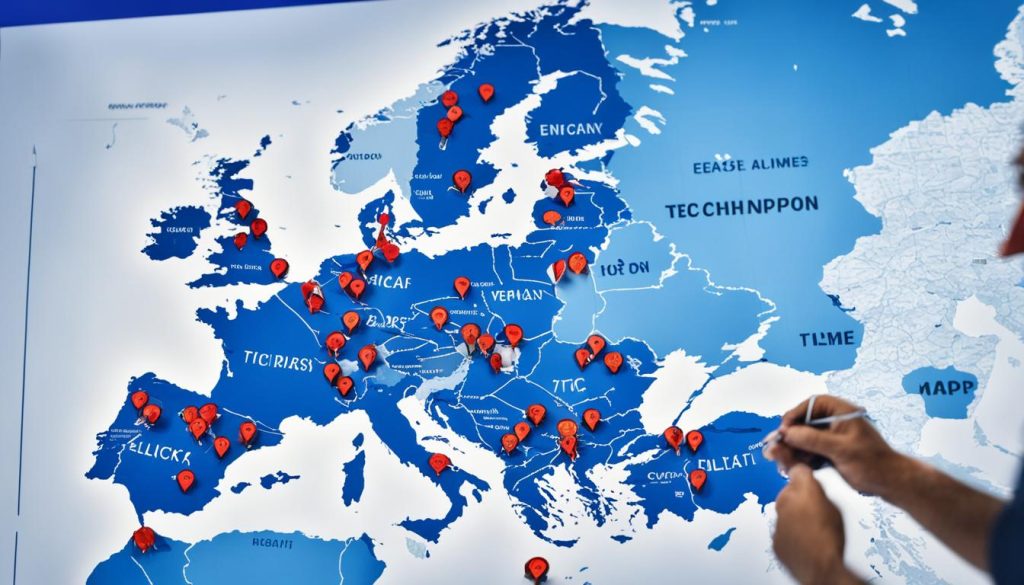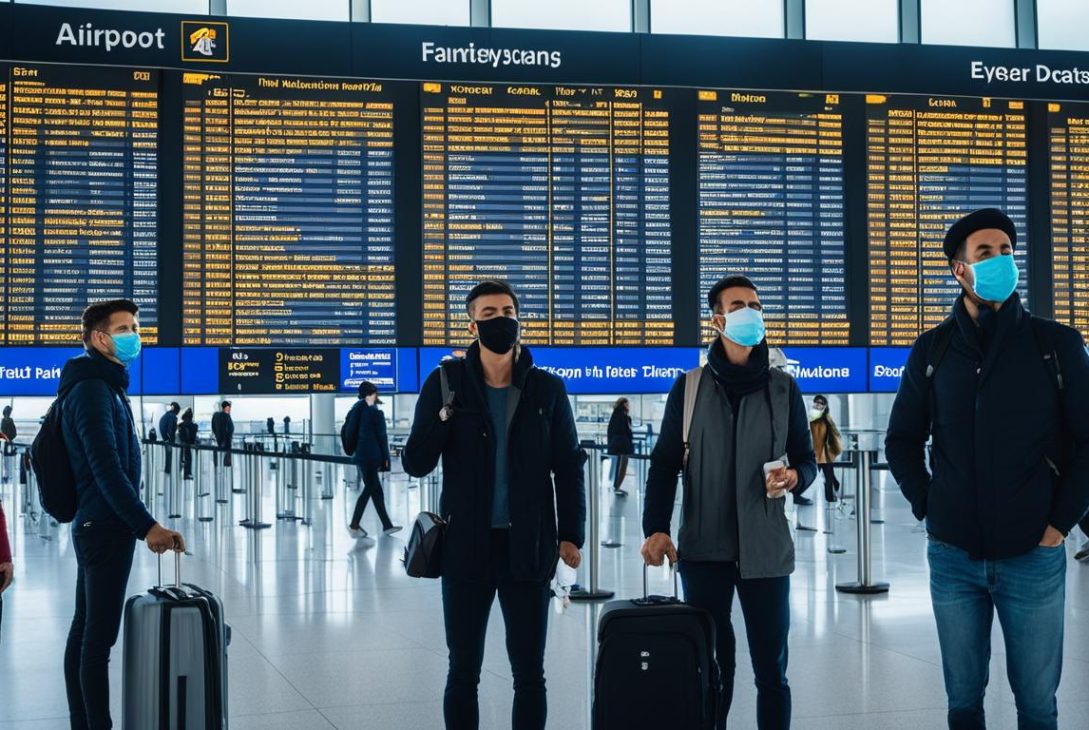When it comes to travel, safety is always a top concern. If you’re considering traveling to Europe or other countries, you may wonder about the current travel safety guidelines and restrictions, particularly in light of the ongoing COVID-19 pandemic. It’s important to stay informed about the latest travel updates and guidelines to ensure a safe and enjoyable trip.
Key Takeaways:
- Europe is generally safe to visit with a low risk of terrorism compared to the US.
- Europe is home to 7 of the world’s 10 safest countries.
- Be mindful of pickpocketing in certain areas and take necessary precautions.
- Check the current travel restrictions and COVID-19 guidelines before planning your trip.
- Follow international travel advice and take travel precautions to ensure your safety.
8 Safety Tips for Visiting Europe
When you’re planning a trip to Europe, it’s essential to prioritize your safety. While Europe is generally a safe destination, it’s always wise to take precautions to protect yourself and your belongings. Here are eight safety tips to keep in mind while visiting Europe:
- Be aware of thieves or muggers working in pairs or small groups. Pickpocketing is a common issue in crowded tourist areas, so stay vigilant and watch out for suspicious individuals.
- Keep an eye on your belongings at all times. It’s crucial to be mindful of your personal belongings, such as your wallet, purse, and phone. Try to avoid carrying valuable items or large amounts of cash.
- Be mindful of your money and spread it around. Instead of keeping all your cash in one place, distribute it among different pockets or hidden compartments in your bag. This way, even if you become a target of pickpocketing, you won’t lose everything.
- Be careful when using ATMs and only use indoor ATMs. Skimming devices and ATM fraud can be a concern in some areas. Choose indoor ATMs located in secure places like banks or shopping centers to minimize the risk of theft.
- Carry a photocopy of your passport with you. In case your passport gets lost or stolen, having a photocopy can expedite the process of obtaining a replacement. Keep the copy separate from your actual passport to avoid losing both at the same time.
- Never leave your drink unattended. Whether you’re at a bar or a social gathering, never leave your drink unattended as it can be easily spiked. Stay cautious and vigilant to ensure your safety.
- Download the Prey app to track your devices. Installing a tracking app like Prey can help you locate your lost or stolen devices. It allows you to remotely control your device, lock it, or even erase your data to protect your privacy.
- Buy travel insurance to protect yourself in case of any unforeseen circumstances. Travel insurance provides coverage for medical emergencies, trip cancellations, and loss of belongings. It gives you peace of mind knowing that you’re financially protected during your trip.
By following these safety tips and being aware of your surroundings, you can ensure a safe and enjoyable trip to Europe.
Safety Tips Summary
| Tips | Description |
|---|---|
| 1 | Be aware of thieves or muggers working in pairs or small groups. |
| 2 | Keep an eye on your belongings at all times. |
| 3 | Be mindful of your money and spread it around. |
| 4 | Be careful when using ATMs and only use indoor ATMs. |
| 5 | Carry a photocopy of your passport with you. |
| 6 | Never leave your drink unattended. |
| 7 | Download the Prey app to track your devices. |
| 8 | Buy travel insurance to protect yourself in case of any unforeseen circumstances. |
What About the War in Ukraine?
The conflict in Ukraine has raised concerns about the safety of travel to Europe. However, it’s important to note that the war in Ukraine is isolated to that specific country and does not directly affect other European countries. While the situation in Ukraine is undoubtedly tragic, it’s essential to understand that the rest of Europe remains a safe destination for travelers.
Travelers can still visit neighboring countries like Poland, Slovakia, Hungary, and Romania, which are not directly involved in the conflict and are considered safe for tourism.
To ensure your safety and peace of mind, it’s recommended to stay informed about the current situation in Ukraine by following reliable news sources and checking travel advisories issued by your government. Additionally, it’s important to keep an eye out for any travel restrictions that may be in place for certain areas within Europe.
“The conflict in Ukraine should not deter you from visiting Europe. The war is confined to Ukraine and does not pose a direct threat to other European countries. However, staying updated on the situation and being aware of any travel restrictions is crucial.”
Europe continues to be a popular and safe travel destination for millions of visitors every year. While it’s natural to have concerns about safety when planning a trip, it’s important to consider the overall stability and security of the region. By staying informed, taking necessary precautions, and following official travel guidelines, you can enjoy a memorable and worry-free journey to Europe.
Travel Restrictions in Europe
| Country | Current Travel Restrictions |
|---|---|
| Poland | No travel restrictions. Open for tourism. |
| Slovakia | No travel restrictions. Open for tourism. |
| Hungary | No travel restrictions. Open for tourism. |
| Romania | No travel restrictions. Open for tourism. |
Note: The table above provides an overview of the current travel restrictions in some neighboring countries of Ukraine. However, it’s important to check the latest travel advisories and guidelines provided by official sources before planning your trip.
What’s the Safest Country in Europe?
When it comes to safety rankings, Europe is known for having some of the safest countries in the world. Among them, Iceland, Ireland, Denmark, and Austria stand out as the top contenders for the title of the safest country in Europe. These countries have consistently low crime rates and are renowned for their peaceful environments, making them ideal destinations for travelers seeking a secure and worry-free experience.

Visitors to Iceland will be captivated by its breathtaking landscapes, including volcanoes, geysers, and glaciers. The country’s small population and emphasis on community safety contribute to its high safety rankings.
Ireland, known as the Emerald Isle, offers a wealth of natural beauty, rich history, and vibrant culture. Its warm and welcoming atmosphere creates a sense of security for travelers.
Denmark, with its picturesque cities and progressive society, is celebrated for its low crime rates and excellent safety standards. Travelers can freely explore the charming streets of Copenhagen and experience the Danish way of life without any major concerns.
Austria, in the heart of Central Europe, boasts stunning Alpine landscapes, historical treasures, and a strong commitment to public safety. Visitors can have peace of mind as they enjoy the country’s renowned hospitality and cultural heritage.
Whether you choose to witness the spectacular natural wonders of Iceland, immerse yourself in the Irish charm, explore the Danish urban landscape, or indulge in the Austrian art and music scene, these countries offer a safe and secure environment for travelers to enjoy their European adventures.
Detailed Safety Rankings of Iceland, Ireland, Denmark, and Austria
| Country | Crime Rate | Public Safety Measures |
|---|---|---|
| Iceland | Low | Strong emphasis on community safety, well-equipped emergency services |
| Ireland | Low | Effective law enforcement, community-oriented policing |
| Denmark | Low | Progressive legal system, well-maintained infrastructure |
| Austria | Low | Frequent police patrols, extensive safety regulations |
Is Europe Safe to Travel Solo?
Traveling solo in Europe can be an exciting and empowering experience for both men and women. Europe, with its developed infrastructure and low crime rates, is generally considered a safe destination for solo travelers. This includes solo female travelers who can explore the continent confidently. However, it is always important to take precautions and stay vigilant regardless of the destination.
Safety Tips for Solo Travelers in Europe
While Europe offers a relatively safe environment for solo travelers, it’s crucial to prioritize your safety. Here are some essential safety tips:
- Research your destination: Familiarize yourself with the local customs, traditions, laws, and potential risks of the country or city you are visiting.
- Share your itinerary and stay connected: Inform a family member or friend about your travel plans, including your accommodations and contact details. Stay connected with them regularly during your trip.
- Stay in safe accommodations: Choose reputable accommodations such as hotels, hostels, or well-reviewed guesthouses. Research the safety measures they provide.
- Avoid walking alone at night: Stick to well-lit and busy areas, especially during the evening. Consider using transportation services or arranging for a safe transfer.
- Blend in with the locals: Avoid drawing unnecessary attention to yourself by dressing modestly and respecting local customs.
- Trust your instincts: If a situation or person makes you uncomfortable, trust your gut and remove yourself from that situation.
- Keep your belongings secure: Use a hidden money belt or a secure bag to carry your valuables. Avoid flashing expensive items.
- Learn basic self-defense techniques: Consider taking a self-defense class before your trip to boost your confidence and preparedness.
Remember that safety should be a top priority, and taking these precautions can help ensure a smooth and enjoyable solo travel experience in Europe.
“Traveling solo in Europe is a rewarding experience that allows you to explore at your own pace. With proper planning and precautions, you can enjoy the beauty and diversity of this continent while staying safe.” – Traveler
Solo Travel Safety: Testimonials from Female Travelers
Many solo female travelers have successfully explored Europe and shared their experiences:
| Traveler | Destination | Experience |
|---|---|---|
| Anna Smith | Spain | “I had an amazing time exploring Spain by myself. The locals were friendly, and I felt safe throughout my trip. I followed basic safety precautions and had no issues.” |
| Laura Johnson | Italy | “Italy was a dream destination for me, and I felt completely safe traveling solo. I used a money belt and stayed in well-located accommodations. I highly recommend it!” |
| Sarah Miller | France | “As a solo female traveler, I had an incredible time in France. I stayed aware of my surroundings, relied on public transportation, and had no safety concerns during my trip.” |
These testimonials reflect the positive experiences of solo female travelers in Europe, highlighting the safety measures they took and the enjoyable trips they had.
In conclusion, Europe can be a safe and welcoming destination for solo travelers, including solo female travelers. By being prepared, informed, and proactive about safety, you can embark on an unforgettable solo adventure in Europe.
Is the Tap Water Safe to Drink in Europe?
The tap water in Europe is generally safe to drink, especially in Western Europe. European countries have strict regulations and standards in place for drinking water safety, ensuring that tap water meets quality requirements.
However, it’s important to note that there may be variations in water quality in rural areas or some beach destinations. In these cases, it’s always a good idea to ask locals or hotel staff about the water quality when you arrive at your destination. They can provide valuable insights and recommendations.
In general, tap water in most European countries is safe for drinking and cooking purposes. It undergoes treatment processes such as filtration, chlorination, and disinfection to remove impurities and ensure its safety. Drinking tap water is not only cost-effective but also helps reduce plastic waste from single-use water bottles.
It’s worth mentioning that some regions in Europe, particularly in Eastern Europe or in countries with older infrastructure, may have lower water quality standards. In such cases, it’s advisable to use bottled water for drinking and brushing teeth, especially if you have a sensitive stomach or are traveling with young children. Bottled water is widely available and easily accessible in most European countries.
Overall, tap water in Europe is safe for the majority of travelers. It’s always a good practice to stay hydrated, particularly during hot weather or when engaging in physical activities. If you’re unsure about the water quality in a specific location, err on the side of caution and choose bottled water.
Why Choose Tap Water in Europe?
Choosing tap water in Europe has several benefits:
- Cost-effective: Tap water is significantly cheaper than bottled water.
- Environmental-friendly: By opting for tap water, you can reduce plastic waste and support sustainable practices.
- Convenience: Tap water is readily available in hotels, restaurants, and public spaces, allowing you to stay hydrated wherever you go.
By being informed and making conscious choices, you can enjoy safe and refreshing tap water throughout your European adventures.
Common Health Concerns in Europe
Europeans generally enjoy good health, but there are some common health concerns in the region. These health concerns include smoking, alcohol abuse, obesity, respiratory diseases, and cancer.
“Smoking, alcohol abuse, obesity, and lack of physical exercise are prevalent issues in Europe.”
Smoking is a major health concern in Europe, with a significant number of people engaging in this harmful habit. The high rates of smoking contribute to various respiratory diseases, including chronic obstructive pulmonary disease (COPD), asthma, and lung cancer.
Alcohol abuse is another significant health concern, as excessive consumption of alcohol can lead to liver disease, cardiovascular problems, and various other health complications. Binge drinking is particularly common among young adults in some European countries.
Obesity is a growing concern in Europe, resulting from sedentary lifestyles, unhealthy diets, and lack of physical exercise. It increases the risk of developing chronic conditions such as diabetes, heart disease, and certain types of cancer.
Respiratory diseases encompass a range of conditions, including asthma, bronchitis, and pneumonia. These diseases can be caused by environmental factors, chronic smoking, and exposure to air pollution.
Cancer is a leading cause of death in Europe, with various types of cancer affecting both men and women. These include lung cancer, breast cancer, colorectal cancer, and prostate cancer. Early detection through regular screenings and maintaining a healthy lifestyle are crucial in reducing the risk of developing cancer.
The recent COVID-19 pandemic has further highlighted the importance of maintaining good health and well-being. The virus has had a detrimental impact on people’s physical and mental health, emphasizing the need for preventive measures, vaccination, and access to quality healthcare.
Prevalence of Health Concerns in Europe:
| Health Concern | Prevalence |
|---|---|
| Smoking | High prevalence, particularly among adults |
| Alcohol Abuse | Varies by country, with binge drinking common among young adults |
| Obesity | Rising rates due to sedentary lifestyles and unhealthy diets |
| Respiratory Diseases | Common, with asthma, COPD, and pneumonia being prevalent |
| Cancer | Leading cause of death, with lung, breast, colorectal, and prostate cancer being common |

Current COVID and Other Vaccination Requirements for Europe
The COVID-19 travel restrictions in Europe have been lifted, and travelers can now visit the region without quarantine requirements. However, vaccination requirements may vary depending on the specific country.
To ensure your safety and protect against potential diseases, it is highly recommended to be up to date with the following vaccines:
- Tetanus
- Diphtheria
- Whooping Cough (Pertussis)
- Measles
- Meningococcal
- Influenza
- Pneumonia
These vaccines are essential for preventing common infections and diseases that may be encountered during travel.
Additional vaccinations may be needed for certain Eastern European countries. It is crucial for travelers to stay informed and updated on the vaccination requirements of their specific destination.
You can check the embassy or official website of your destination for the latest vaccination guidelines and recommendations. It is always better to consult with healthcare professionals or travel clinics to ensure you have the necessary vaccinations before your trip.
COVID-19 Vaccination
In addition to routine vaccinations, it is important to consider getting vaccinated against COVID-19 before traveling to Europe. COVID-19 vaccines have been proven to be effective in preventing severe illness and reducing the spread of the virus.
“The COVID-19 vaccine is a crucial tool in fighting the pandemic and ensuring the safety of travelers. It is strongly recommended to get vaccinated against COVID-19 before embarking on any international travel.”
By getting vaccinated, you not only protect yourself but also contribute to the overall health and well-being of the communities you visit.
| Vaccine | Doses Required | Recommended Timing before Travel |
|---|---|---|
| Moderna | 2 doses | Complete vaccination at least 2 weeks before travel |
| Pfizer-BioNTech | 2 doses | Complete vaccination at least 2 weeks before travel |
| AstraZeneca | 2 doses | Complete vaccination at least 4 weeks before travel |
| Johnson & Johnson | 1 dose | Complete vaccination at least 2 weeks before travel |
Remember, vaccination is a crucial step in ensuring your safety and the safety of others while traveling. Stay informed, follow the guidelines, and enjoy your trip to Europe with peace of mind.
Common Safety Risks for Travelers to Europe
When planning a trip to Europe, it’s important to be aware of common safety risks that travelers may encounter. By understanding these risks and taking necessary precautions, you can ensure a safe and enjoyable experience during your travels.
Balconing: A Dangerous Trend
One safety risk that has emerged in some European destinations is balconing. This refers to the act of jumping from balconies into swimming pools, which has gained popularity among certain individuals. However, it’s crucial to note that balconing can be extremely dangerous, leading to serious injuries or even fatalities. To avoid any potential harm, it is strongly advised to refrain from participating in such activities.
Binge Drinking: Exercise Caution
In certain parts of Europe, binge drinking is a concern, particularly in Northern and Eastern European countries. Excessive alcohol consumption can impair judgment, making individuals more vulnerable to accidents, theft, or other risky situations. It’s important to exercise caution and drink responsibly while enjoying the vibrant nightlife that Europe offers.
Pickpocketing and Theft
As with any popular tourist destination, pickpocketing and theft can occur in Europe. It’s essential to be mindful of your belongings and take precautionary measures to protect yourself. Some tips to consider include keeping your valuables secure, using anti-theft bags or accessories, and avoiding crowded areas where pickpockets may operate.
Terrorism and Political Unrest
While the risk of terrorism and political unrest exists globally, it is important to stay informed about the current situation in the countries you plan to visit. Stay aware of any travel advisories or warnings issued by your government or relevant authorities and adjust your travel plans accordingly. Avoid large gatherings, protests, or demonstrations, and be vigilant of your surroundings at all times.

Risk of Driving and Other Accidents in Europe
When it comes to driving in Europe, it is generally safe, but there are a few factors to consider. Road conditions and driving styles can vary from country to country, so it’s important to familiarize yourself with the local rules and regulations. Some countries in eastern and southeastern Europe have higher accident rates, so extra caution is advised in these areas.
Following local traffic rules is crucial for road safety in Europe. This includes obeying speed limits, using seat belts, and being mindful of pedestrians and cyclists. Additionally, avoid distractions, such as using mobile devices while driving, and never drink and drive.

It’s worth noting that the rising popularity of e-scooters and other alternative modes of transportation has led to an increase in accidents, particularly in tourist cities. If you choose to use e-scooters, exercise caution and follow the local regulations. Be aware of pedestrians and other vehicles, and always wear a helmet for your safety.
| Country | Accident Rate |
|---|---|
| Germany | 9.5 accidents per 1,000 vehicles |
| France | 11.2 accidents per 1,000 vehicles |
| Italy | 13.8 accidents per 1,000 vehicles |
| Spain | 10.1 accidents per 1,000 vehicles |
Note: The accident rates mentioned above are based on data from 2020 and represent the number of accidents per 1,000 vehicles in each country.
To ensure a safe and enjoyable driving experience in Europe, it’s recommended to plan your routes in advance, allow extra time for travel, and stay updated on road conditions and potential hazards. By taking these precautions, you can minimize the risk of accidents and make the most of your journey throughout Europe.
Documentation Needed to Visit Europe
Traveling to Europe requires certain documentation to ensure a smooth and hassle-free trip. Here are the essential documents you’ll need:
1. Valid Passport or ID Card
A valid passport or ID card is a must when traveling to Europe. Make sure your passport has at least six months of validity remaining from the date of entry. Some countries may accept ID cards for EU and EEA citizens, but it’s always best to carry a passport for international travel.
2. Travel Itinerary
It’s important to have a well-planned travel itinerary that includes your intended destinations, accommodations, and duration of stay. This itinerary helps border control officers assess the purpose and length of your visit. Be prepared to provide a detailed itinerary when requested.
3. Schengen Visa (if applicable)
If you’re planning to visit countries within the Schengen Area, which includes most European countries, you may need a Schengen visa. The visa requirement depends on your nationality. Some countries have visa-free agreements, while others require a visa. Check with the embassy or official website of your destination for specific visa requirements.
4. UK Visa (if applicable)
If you’re planning to visit the United Kingdom, you may need a visa depending on your nationality. The visa requirements for the UK are separate from the Schengen visa. Travelers should consult the UK government website for the latest information and visa requirements.
Remember to carry all necessary documents with you during your travels and keep them in a secure place. It’s also a good idea to make copies of your passport and other important documents in case of loss or theft. By ensuring you have the required documentation, you can enjoy a stress-free journey to Europe.
Conclusion
Traveling to Europe is a wonderful experience that offers a diverse range of cultures, history, and landscapes. The good news is that Europe is generally a safe destination for travelers, with low crime rates and a strong focus on tourism safety. Whether you’re exploring the bustling streets of Rome, admiring the majestic beauty of the Swiss Alps, or immersing yourself in the vibrant nightlife of Berlin, you can have peace of mind knowing that Europe is a safe place to visit.
Of course, it’s always important to take precautions and stay informed about the current situation. By following a few simple safety tips, you can minimize potential risks and ensure a smooth and enjoyable trip. Be aware of pickpocketing and keep an eye on your belongings at all times. Keep your money secure, be cautious when using ATMs, and carry a photocopy of your passport with you. These small steps can go a long way in protecting yourself while you explore the wonders of Europe.
Europe’s commitment to tourism safety is evident in its strong infrastructure, well-regulated transportation systems, and the presence of law enforcement agencies. The continent also offers a wide array of travel insurance options to provide you with added financial protection and peace of mind. So before embarking on your journey, consider purchasing travel insurance that suits your needs.
With its rich history, world-class attractions, and diverse landscapes, Europe continues to captivate travelers from around the globe. By being mindful of safety precautions, staying informed, and exercising caution, you can embark on an unforgettable journey through Europe while enjoying the peace of mind that comes with traveling to a safe destination.
FAQ
Is traveling safe to Europe & other countries now?
Yes, traveling to Europe is generally safe. Europe is home to several of the world’s safest countries and has a low risk of terrorism compared to the US. However, it’s important to take precautions and stay updated on any travel restrictions or guidelines.
What are some safety tips for visiting Europe?
Here are some safety tips for visiting Europe:
– Be aware of thieves or muggers working in pairs or small groups.
– Keep an eye on your belongings at all times.
– Be mindful of your money and spread it around.
– Be careful when using ATMs and only use indoor ATMs.
– Carry a photocopy of your passport with you.
– Never leave your drink unattended.
– Download the Prey app to track your devices.
– Buy travel insurance to protect yourself in case of any unforeseen circumstances.
What about the war in Ukraine?
The conflict in Ukraine is isolated to Ukraine and does not affect other European countries. Travelers can still visit neighboring countries like Poland, Slovakia, Hungary, and Romania, which are considered safe. It’s important to stay updated on the current situation and check for any travel restrictions to certain areas.
What’s the safest country in Europe?
Iceland, Ireland, Denmark, and Austria are considered the safest countries in Europe. These countries have low crime rates and are known for their peaceful environments. Visitors can feel safe and secure when traveling to these destinations.
Is Europe safe to travel solo?
Yes, Europe is generally safe for solo travelers, including solo female travelers. With its developed infrastructure and low crime rates, Europe is an ideal destination for those who want to explore on their own. However, it’s always important to take precautions and stay vigilant, regardless of the destination.
Is the tap water safe to drink in Europe?
Yes, tap water in Europe is generally safe to drink, especially in Western Europe. However, there may be variations in water quality in rural areas or some beach destinations. It’s always a good idea to ask locals about the water quality when you arrive. In general, tap water is safe for drinking and cooking purposes in most European countries.
What are common health concerns in Europe?
Smoking, alcohol abuse, obesity, and lack of physical exercise are prevalent health issues in Europe. Circulatory and respiratory diseases, as well as various types of cancer, are leading causes of death. The recent COVID-19 pandemic has also had a negative impact on people’s physical and mental health.
What are the current COVID and other vaccination requirements for Europe?
COVID-19 travel restrictions in Europe have been lifted, and travelers can now visit the region without quarantine requirements. However, vaccination requirements may vary depending on the specific country. It is recommended to be up to date with vaccines such as tetanus, diphtheria, whooping cough, measles, meningococcal, influenza, and pneumonia. Additional vaccinations may be needed for certain Eastern European countries. Travelers should check the embassy or official website of their destination for the latest vaccination requirements.
What are common safety risks for travelers to Europe?
Common safety risks for travelers to Europe include activities like balconing, binge drinking, pickpocketing, theft, terrorism, and political unrest. It is important to research and be cautious of potential dangers before visiting any specific location.
What is the risk of driving and other accidents in Europe?
While driving in Europe is generally safe, road conditions and driving styles can vary from country to country. Some countries have higher accident rates, especially in eastern and southeastern Europe. It is important to follow local traffic rules and be cautious on the road. Additionally, the increasing popularity of e-scooters and other alternative modes of transportation has led to an increase in accidents, especially in tourist cities. Visitors should exercise caution when using these forms of transportation.
What documentation is needed to visit Europe?
To visit Europe, travelers generally need a valid passport or ID card and a travel itinerary. If traveling to the Schengen zone, a Schengen visa may be required, depending on the traveler’s nationality. It is important to check the specific requirements with the embassy or official website of the destination. For travel to the UK, a visa may also be required, and travelers should consult the UK government website for the latest information.
Source Links
- https://www.nomadicmatt.com/travel-blogs/is-europe-safe-to-visit-right-now/
- https://www.axa-schengen.com/en/traveling-Europe-safety-tips
- https://www.usnews.com/news/best-countries/articles/places-the-us-government-warns-not-to-travel-right-now
Last modified: December 28, 2023





